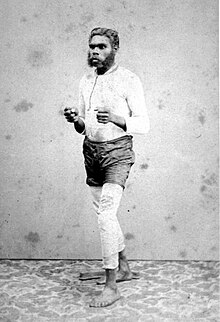Albert "Pompey" Austin
| Albert "Pompey" Austin | |||
|---|---|---|---|
 A portrait of Austin in 1880 | |||
| Personal information | |||
| Full name | Poorne Yarriworri | ||
| Nickname(s) | Pompey | ||
| Date of birth | c. 1844 | ||
| Place of birth | Camperdown, Victoria | ||
| Date of death | 1889 (aged 44–45) | ||
| Place of death | Melbourne, Victoria | ||
| Playing career1 | |||
| Years | Club | Games (Goals) | |
| 1872 | Geelong | 1 (0) | |
|
1 Playing statistics correct to the end of 1872. | |||
Albert "Pompey" Austin (born Poorne Yarriworri; c. 1844–1889) was an Australian athlete, tracker, entertainer and sportsman. Austin is recognised as the first Indigenous Australian to play senior Australian rules football in Victoria, when he played a single game for the Geelong Football Club in 1872.
Early life
[edit]Austin was born in the mid-1840s near Camperdown in Victoria.[1] A Djab Wurrung man, he lived at the Framlingham mission near Warrnambool.[1]
Sporting career
[edit]
Austin was well known for his athletic ability, adept in numerous track and field events as well as Australian rules football, cricket, and possibly boxing and horse racing.[2] In 1869, he won the high jump, pole vault and 220-yard hurdles at the Warrnambool Cricket Club annual sports day. Arguably his greatest feat was winning the Geelong Friendly Societies’ Gift at Easter time in 1872, walking away with a £10 prize.[1][3] Austin played one game for Geelong against Carlton on 25 May 1872.[4][5] A year later, at the Belfast Athletic Sports meet, Austin won the handicap hurdles, steeplechase, and 880-yard Christmas handicap. His prize was the equivalent of 11 weeks' wages.[6]
Despite being "poleaxed" in his one and only game for Geelong, Austin would in years later return to the football field for various clubs in the Western District, including Framlingham, Cobden, and Albion Imperial.[2]
Professional career
[edit]Austin worked in the Kimberley region of Western Australia with explorer William J. O'Donnell, leading gold seekers from Wyndham to the emerging goldfields at Halls Creek.[7] Australian novelist Mary Durack recorded that gold seekers heading to Halls Creek told of O'Donnell, William Carr Boyd and "that flash ... Pompey" leading them through the rugged country from Wyndham for "a pound a head".[7][8] A landmark near Halls Creek, a rocky outcrop known as Pompey's Pillar, is named after Austin.[7]
Personal life
[edit]Austin married Rosanna Francis in 1867.[9] They had five children together.[10] Austin died of tuberculosis in a Melbourne hospital in 1889.[9][10][11]
Legacy
[edit]Austin's recognition was increased in the early 21st century when multiple media outlets ran news outlets highlighting his story as the first Indigenous Australian to play Australian rules football for a recognised club.[11][2] Austin's short-lived career occurred more than three decades before the more highly publicised Joe Johnson, the first Indigenous Australian to compete in the Victorian Football League. Geelong would not have another Indigenous Australian represent the club until Polly Farmer debuted in 1962, almost 90 years after Austin's solitary match.
Historian Roy Hay published the first biography of Austin, Albert 'Pompey' Austin: A man between two worlds, in 2020.[11]
Austin was posthumously inducted into the Victorian Aboriginal Honour Roll by the Victorian Government in October 2022.[12]
References
[edit]- ^ a b c Ruddell, Trevor. "Australian Football - Pompey Austin - Aboriginal pioneer". australianfootball.com. Retrieved 22 August 2020.
- ^ a b c Hay, Roy (25 May 2022). "The Albert 'Pompey' Austin Story". Geelong Cats. Retrieved 6 September 2023.
- ^ Hay, Roy (2 October 2017). "Pompey Austin: an Australian sporting hero deserving of recognition". the Guardian. Retrieved 22 August 2020.
- ^ "FOOTBALL". Geelong Advertiser. No. 7, 865. Victoria, Australia. 27 May 1872. p. 3. Retrieved 22 August 2020 – via National Library of Australia.
- ^ Trevor Ruddell, “Albert ‘Pompey’ Austin: the first Aborigine to play senior football” in Peter Burke and June Senyard (ed.), Behind the Play: Football in Australia. Maribyrnong Press, Hawthorn (Vic.), 2008, pp. 89-105.
- ^ Ward, Cam (28 May 2022). "Indigenous trailblazer Albert "Pompey" Austin's story shared". Geelong Advertiser. Retrieved 6 September 2023.
- ^ a b c Himmelreich, Everard (6 September 2019). "How did a landmark in the Kimberley come to be named after a former son of Framlingham?". The Standard. Retrieved 22 August 2020.
- ^ Durack, Mary (2008), Kings in grass castles, Random House, ISBN 978-1-74166-759-2
- ^ a b Hay, Roy (2 February 2017). "Albert 'Pompey' Austin, 1846?-1889: A Man Between Two Worlds". Contemporary Histories Research Group at Deakin University. Retrieved 22 August 2020.
- ^ a b "Albert Pompey Austin". First Peoples – State Relations. 28 October 2022. Retrieved 6 September 2023.
- ^ a b c Mark, David (20 August 2020). "Albert 'Pompey' Austin remembered as first Indigenous footballer to play at the highest level". ABC News. Retrieved 6 September 2023.
- ^ "Celebrating Victoria's Aboriginal Leaders". Premier of Victoria. 25 October 2022. Retrieved 6 September 2023.
